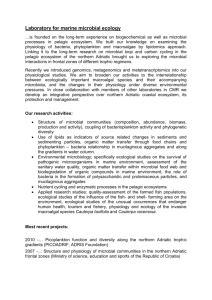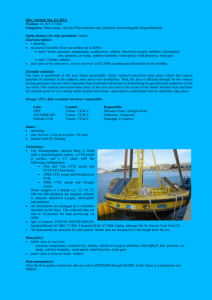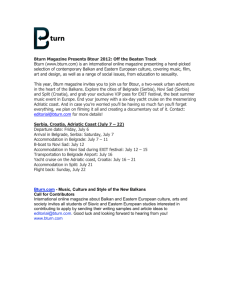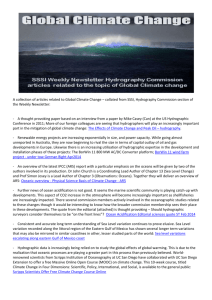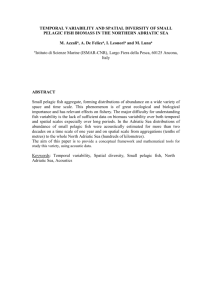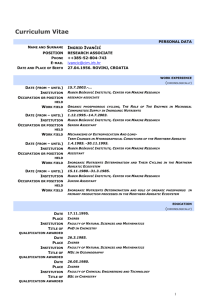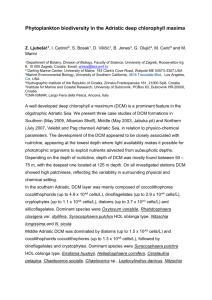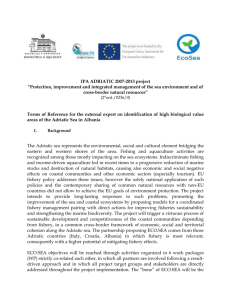2001 - Permanent Service for Mean Sea Level
advertisement
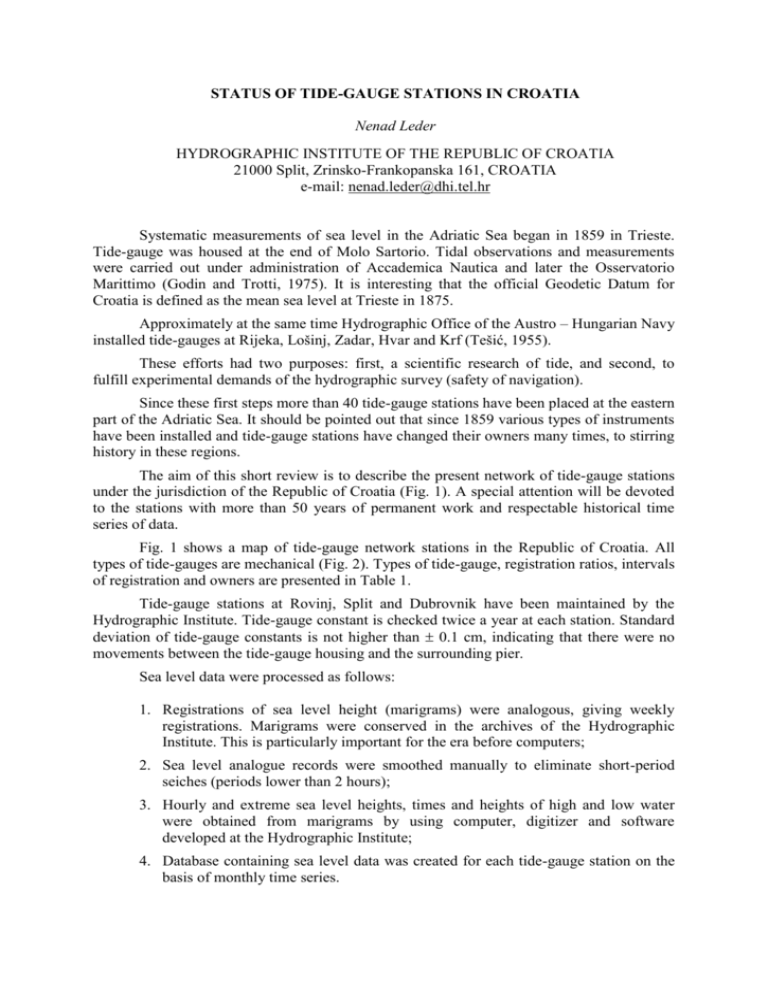
STATUS OF TIDE-GAUGE STATIONS IN CROATIA Nenad Leder HYDROGRAPHIC INSTITUTE OF THE REPUBLIC OF CROATIA 21000 Split, Zrinsko-Frankopanska 161, CROATIA e-mail: nenad.leder@dhi.tel.hr Systematic measurements of sea level in the Adriatic Sea began in 1859 in Trieste. Tide-gauge was housed at the end of Molo Sartorio. Tidal observations and measurements were carried out under administration of Accademica Nautica and later the Osservatorio Marittimo (Godin and Trotti, 1975). It is interesting that the official Geodetic Datum for Croatia is defined as the mean sea level at Trieste in 1875. Approximately at the same time Hydrographic Office of the Austro – Hungarian Navy installed tide-gauges at Rijeka, Lošinj, Zadar, Hvar and Krf (Tešić, 1955). These efforts had two purposes: first, a scientific research of tide, and second, to fulfill experimental demands of the hydrographic survey (safety of navigation). Since these first steps more than 40 tide-gauge stations have been placed at the eastern part of the Adriatic Sea. It should be pointed out that since 1859 various types of instruments have been installed and tide-gauge stations have changed their owners many times, to stirring history in these regions. The aim of this short review is to describe the present network of tide-gauge stations under the jurisdiction of the Republic of Croatia (Fig. 1). A special attention will be devoted to the stations with more than 50 years of permanent work and respectable historical time series of data. Fig. 1 shows a map of tide-gauge network stations in the Republic of Croatia. All types of tide-gauges are mechanical (Fig. 2). Types of tide-gauge, registration ratios, intervals of registration and owners are presented in Table 1. Tide-gauge stations at Rovinj, Split and Dubrovnik have been maintained by the Hydrographic Institute. Tide-gauge constant is checked twice a year at each station. Standard deviation of tide-gauge constants is not higher than 0.1 cm, indicating that there were no movements between the tide-gauge housing and the surrounding pier. Sea level data were processed as follows: 1. Registrations of sea level height (marigrams) were analogous, giving weekly registrations. Marigrams were conserved in the archives of the Hydrographic Institute. This is particularly important for the era before computers; 2. Sea level analogue records were smoothed manually to eliminate short-period seiches (periods lower than 2 hours); 3. Hourly and extreme sea level heights, times and heights of high and low water were obtained from marigrams by using computer, digitizer and software developed at the Hydrographic Institute; 4. Database containing sea level data was created for each tide-gauge station on the basis of monthly time series. Fig. 1 Tide-gauge stations operating along the east Adriatic coast. Fig. 2 Mechanical tide-gauge A. Ott – Kempten at Split. The results of sea level measurements have been published every year since 1955 in the publication “Report on tide-gauge measurements along the east Adriatic coast”, issued by Hydrographic Institute. The first results of harmonic analysis of tides along the east coast of the Adriatic Sea were published by W. Kesslitz (1919). In Croatia, harmonic constants were first determined for Bakar by Kasumović (1952), on the basis of hourly sea level heights measured in 1950. According to the instructions of Kasumović, Šigud (1973) calculated harmonic constants for 6 stations along the east Adriatic coast. Harmonic constants for Rovinj, Split and Dubrovnik are shown in Table 2. On the basis of harmonic constants determined by Kasumović and Šigud, Hydrographic Institute has been performing harmonic synthesis of tides since 1974. Predicted sea level data have been published in publication “Tide tables, Adriatic Sea – east coast”, issued by Hydrographic Institute. Table 1. Types of tide gauges, registration ratios, intervals of registration and owners for the Croatian tide-gauge network. STATION TYPE OF TIDEGAUGE REGISTRATION RATIO INTERVAL OF REGISTRATION A.OTT Kempten 1:5 1955-1999 BAKAR A.OTT Kempten 1:5 1929-1939 1949-1999 ZADAR A.OTT Kempten 1:5 1991-1999 SPLITLUKA A.OTT Kempten 1:5 1929-1941 1947-1999 SPLIT-RT MARJAN A.OTT Kempten 1:5 1952-1999 SUĆURAJ Fuess 1:10 1986-1999 A.OTT Kempten 1:5 1954-1999 ROVINJ DUBROVNIK OWNER Hydrographic InstituteSplit Andrija Mohorovičić Geophysical InstituteZagreb Hydrographic InstituteSplit Hydrographic InstituteSplit Institute of Oceanography and Fisheries-Split Hydrographic InstituteSplit Hydrographic InstituteSplit Table 2. General data and harmonic constants for Rovinj, Split and Dubrovnik. Harmonic constants Standard Port Geographical coordinates Z0 Rovinj = 45o 05’N = 13o 38’E Split Dubrovnik = 43o 30’N = 16o 26’E = 42o 40’N = 18o 04’E const M2 48 H g 19.30 271.5 20 H g 18 H g S2 N2 K2 K1 O1 P1 10.78 280.1 2.99 263.8 3.08 269.9 16.35 71.8 5.04 57.9 5.25 68.4 7.95 129.0 5.58 130.8 1.38 125.6 1.64 124.1 8.82 55.9 2.69 47.5 2.90 51.8 9.28 115.1 5.76 120.4 1.68 110.6 1.65 115.7 5.19 62.4 1.90 47.3 1.69 60.2 Parameters presented in Table 2 are as follows: Z0 H g M2 S2 N2 K2 K1 O1 P1 - Mean water level above Chart Datum - Mean amplitude of a tidal constituent - Modified epoch of a tidal constituent - Principal lunar semidiurnal constituent - Principal solar semidiurnal constituent - Larger lunar elliptic semidiurnal constituent - Lunisolar semidiurnal constituent - Lunisolar diurnal constituent - Lunar diurnal constituent - Solar diurnal constituent An impressive database of sea level data measured along the east coast of the Adriatic Sea was elements of scientific research. Many professional and scientific papers were published in Croatian and international journals, by Croatian and foreign scientists. The list of scientific papers published in international journals by the scientists from Hydrographic Institute of the Republic of Croatia, in the last five years is as follows: Vilibić, I., Leder, N. (1996): Long-term variations of Mediterranean Sea level calculated by spectral analysis, Oceanologica Acta, 19, 599-607. Vilibić, I. (1997): Global sea level rise? New techniques of measuring the absolute sea level, Geofizika, 14, 119-131. Vilibić, I. (1998): Variations of the Sa and Ssa tides in the Adriatic Sea, Acta Adriatica, 39 (1), 53-60. Vilibić, I., Leder, N., Smirčić, A. (1998): Forced and free response of the Adriatic Sea level, Il Nuovo Cimento C, 21, 439-451. Raicich, F., Orlić, M., Vilibić, I., Malačič, V. (1999): A case study of the Adriatic seiches (December 1997), Il Nuovo Cimento C, 22, 715-726. Vilibić, I. (1999): The climatology of the main Adriatic seiche, EGS XXIV General Assembly, The Hague, April. Vilibić, I., Orlić, M. (1999): Surface seiches and internal Kelvin waves observed off Zadar (east Adriatic), Estuarine, Coastal and Shelf Science, 48, 125-136. Mihanović, H., Orlić, M., Vilibić, I. (2000): Seiches of the Lim Channel (north Adriatic): empirical and numerical approach, European Geophysical Society, XXV General Assembly, Nice, April. LITERATURE: Godin, G. and L. Trotti (1975): Trieste, Water Levels 1952-1971: A Study of the Tide, Mean Level and Seiche activity. Miscellaneous Special Publication 28, Ottawa, 1-24. Kasumović, M. (1952): Harmonic analysis of tides at Bakar (in Croatian). Geofizički institut Prirodoslovno-matematičog fakulteta Sveučilišta u Zagrebu, Radovi III/1, Zagreb, 1-9. Kesslitz, W. (1919): Die Gezeitenerscheinungen in der Adria, Die Beobachtungsergebnisse der Flutstationen, Denkschrichts d. Akad. Wiss., XCVI, Wien. Šigud, J. (1973): Tide tables, Adriatic Sea – east coast - 1974 (in Croatian), Hidrografski institut JRM, Split. Tešić, M. (1955): Tide observations in the Adriatic Sea (in Croatian). Hidrografski godišnjak 1954, Hidrografski institut JRM, 181-20

